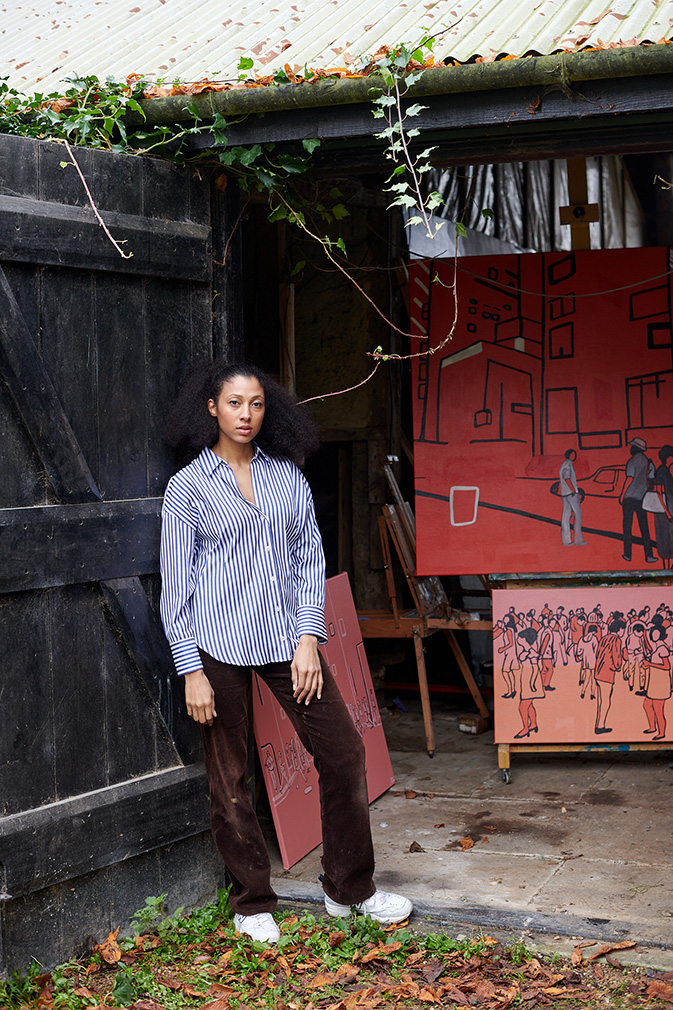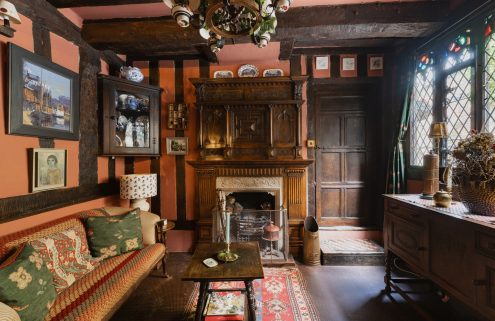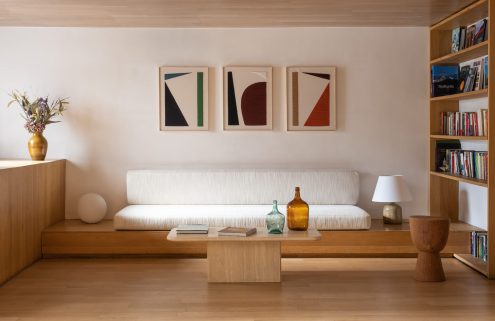In February 2023, artist Edwina Longe decided to up-sticks and relocate from her South London studio to rural Suffolk, where the family have lived in a 16th-century farmhouse since she was two. With a painting practice founded on the flux of the city, her transition to rural East England has offered new perspectives and ignited new routines around her work.
Photographer and writer Louise Long visited her on a chilly winter day to explore the studio outbuildings abutting the family’s farmhouse: spaces she shares not only with older sister and fellow artist Sahara Longe but also peacocks, chickens and rescue dogs who call the place home.
When did painting begin for you?
I’ve always painted – it was my leading subject at school, and I always painted in my free time. I studied a Foundation at Leeds in Fine Art and then curating at Central St Martins. [In] the last two years, I got back into it, inspired by living again with Sahara during the pandemic and being surrounded by so much painting, and since the end of 2022, I have been working with the art platform Wondering People.

Your process often involves translating charcoal drawings into graphic, strident street scenes. How do you approach an idea for a canvas?
The street scenes are inspired by when I lived in London and [capture] everyday life. I like the idea that we’re all so busy, and everyone is going their own way… We’re all humans, but we look so different. The buildings I paint without much detail – life is so busy we forget to see the details around us, which are actually rather beautiful. If you actually stopped, you might notice that you’re surrounded by amazing things.
Alongside your London street scenes, you have a series of tropical, lush landscapes. Tell us about this work.
Sierra Leone is where my mum is from. I wanted to capture its essence: the jungles, beaches, and vibrant tropical colours I feel the country has. My Sierra Leone work is very recent – I started experimenting with that more after being inspired by my last visit. I go every year to visit my grandmother. Sometimes, I paint from photos I’ve taken when I’m there, and sometimes, I create something from the inspiration of the last visit. I can be working on eight paintings concurrently. I’m always starting new things and then stopping – it’s a lot of layers, and you have to come back to it.

Photography: Louise Long

Photography: Louise Long

Watching by Edwina Longe. Courtesy Wondering People

SEEN by Edwina Longe

Photography: Louise Long

Photography: Louise Long

Photography: Louise Long
Why did you choose to move back to Suffolk, and what has the transition been like?
I really enjoyed working in the London studio because I was in the middle of Brixton High Street, and there was always noise and characters to be found. But I wanted more space to work in, and I was able to turn an old barn used for storing farm machinery into a studio, which gave me more freedom with the size of [my] work. Now, in Suffolk, I certainly have a lot more space, and it’s more peaceful, which is a huge contrast to the lively scenes of south London.
There’s no one around, so I’m free to come up with things and really think about my painting. Working next to Sahara, too – the two of us getting up at the same time, talking about each other’s work – I find that really inspiring. [And] I go up to London to see the current shows for inspiration.
You have various workspaces across the house and barns, such as storage, painting, stretching canvas, and fixing frames. How do you organise your practice across these spaces?
We live on a small farm, so there are lots of outbuildings to work in. They were used for storing farm machinery and for cows way back in the day. We swap studios a lot, depending on the season, and because some of them are larger than others. I move around the spaces and see what I’m inspired by. The barn has a large set of doors, which, when opened, let in a lot of light, which is great for painting in the summer. But now it’s winter, we have to start getting up at 7 am! We found an old animal bone in a wall, which apparently was to ward off bad spirits.

What is the most challenging aspect of working in these spaces?
The barns are very badly insulated, so it can make for incredibly cold and challenging painting sessions. In the winter it can be too cold to use them at times. However, the use of gloves and a tucked-in hot water bottle helps. And lots of cups of tea!
What are you focused on next?
I’m going to start going more towards street scenes – exploring and pushing the boundaries on that more and playing with colours and formats. Giant paintings have a great impact – but some things captured in a small painting can be just as interesting. I like to play with different scales and sizes.
All four of your sisters were at home during the pandemic. What does the rest of the family make of you and Sahara painting in Suffolk?
They think it’s great! My parents aren’t artists but have always encouraged me to pursue my interests. But they are a bit sick of us getting paint on everything! And there are no clean cups left in the house…
Edwina Longe’s work is available through the emerging artist collective Wondering People.


























